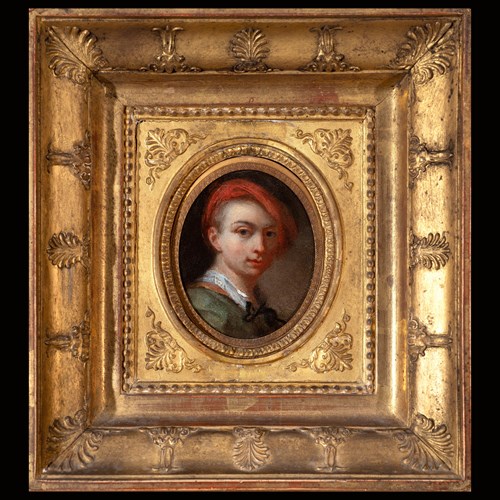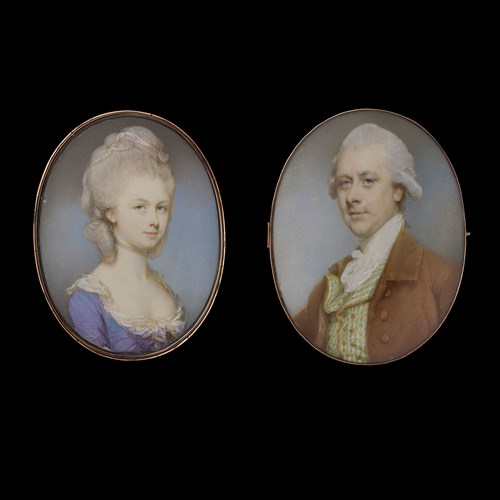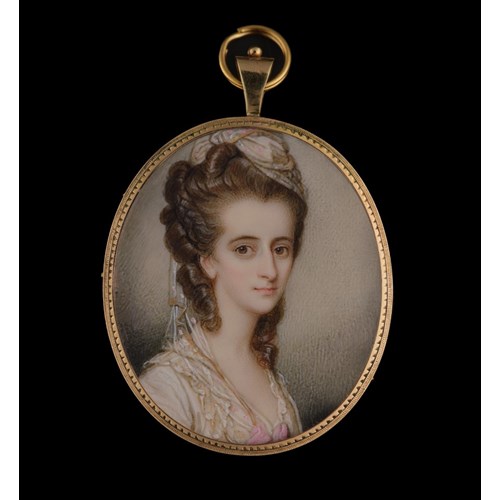Marketplace
Portrait miniature of Marie-Antoinette, Queen of France (1755-1793), profile to the left, wearing white gown, pearl necklace and earrings and pearl and ostrich feather bandeau over the powdered hair
CHARLES GUILLAUME ALEXANDRE BOURGEOIS
Portrait miniature of Marie-Antoinette, Queen of France (1755-1793), profile to the left, wearing white gown, pearl necklace and earrings and pearl and ostrich feather bandeau over the powdered hair
The Limner Company : Portrait Miniature
Date Circa 1790
Medium Watercolour on ivory
Dimension 7.3 cm (2⁷/₈ inches)
En grisalle profile portraits of Marie-Antoinette, Louis XVI and their children were produced by various court artists during their lifetimes, as well as after their deaths by guillotine. A form of ‘trompe-l'œil’, these painted portraits resembled cameos or sculpture were extremely fashionable from the last quarter of the eighteenth century. Their lack of colour elevated the subject matter to the status of antique marble sculpture, imbuing an enduring and timeless quality to the sitter. The locks of hair surrounding the crown in the glazed reverse of this frame are from, or allude to, the royal family of six (Louis XVI, Marie-Antoinette and their four children).
These miniatures were often given as gifts of thanks to favoured courtiers – for example, one such miniature by Piat Joseph Sauvage (1744-1818) was said to have been given by the king to Jean Baptiste Pierre Antoine, Chevalier de Lamarck, a botanist of the Academie des Sciences who became a professor of zoology in 1794 and was awarded the Order of the Légion d'Honneur.
This type of ‘cameo’ miniature was also painted by the artist Louis-Bertin Parant (1768-1851). He worked in the porcelain manufactory of Sèvres and specialised in this fashion for paintings which resembled cameos or sculptures.
Marie-Antoinette was a daughter of Maria Theresa and the Emperor Francis I. She married the future Louis XVI of France in 1770, becoming queen four years later. She became a focus for opposition to reform and won widespread unpopularity through her extravagant lifestyle. The royal family was forcibly brought from Versailles to Paris in October 1789 and their attempt to flee the country in 1791 ended when they reached Varennes. Like her husband Louis XVI, she was imprisoned during the French Revolution and eventually executed the year after her husband was guillotined, in October 1793.
This is a variation of a miniature signed by Louis-Bertin Parant (1768-1851) in the National Museum, Stockholm, where the profiles face to the right. Parant specialised in miniatures imitating cameos. He worked in the porcelain manufactory of Sèvres and also produced lithographs. Napoleon I, his wife Josephine and Louis XVIII were among his patrons. Parant exhibited at the Paris Salon between 1800 and 1834.[1]
[1] Versions of his miniatures can be found in the Nationalmuseum Stockholm and the Royal Collection, London.
These miniatures were often given as gifts of thanks to favoured courtiers – for example, one such miniature by Piat Joseph Sauvage (1744-1818) was said to have been given by the king to Jean Baptiste Pierre Antoine, Chevalier de Lamarck, a botanist of the Academie des Sciences who became a professor of zoology in 1794 and was awarded the Order of the Légion d'Honneur.
This type of ‘cameo’ miniature was also painted by the artist Louis-Bertin Parant (1768-1851). He worked in the porcelain manufactory of Sèvres and specialised in this fashion for paintings which resembled cameos or sculptures.
Marie-Antoinette was a daughter of Maria Theresa and the Emperor Francis I. She married the future Louis XVI of France in 1770, becoming queen four years later. She became a focus for opposition to reform and won widespread unpopularity through her extravagant lifestyle. The royal family was forcibly brought from Versailles to Paris in October 1789 and their attempt to flee the country in 1791 ended when they reached Varennes. Like her husband Louis XVI, she was imprisoned during the French Revolution and eventually executed the year after her husband was guillotined, in October 1793.
This is a variation of a miniature signed by Louis-Bertin Parant (1768-1851) in the National Museum, Stockholm, where the profiles face to the right. Parant specialised in miniatures imitating cameos. He worked in the porcelain manufactory of Sèvres and also produced lithographs. Napoleon I, his wife Josephine and Louis XVIII were among his patrons. Parant exhibited at the Paris Salon between 1800 and 1834.[1]
[1] Versions of his miniatures can be found in the Nationalmuseum Stockholm and the Royal Collection, London.
Date: Circa 1790
Medium: Watercolour on ivory
Dimension: 7.3 cm (2⁷/₈ inches)
Provenance: Private Collection, UK.
Plus d'œuvres d'art de la Galerie


, profile to the left, wearing white g_T638964936170446054.jpg?width=2000&height=2000&mode=max&scale=both&qlt=90)



 when Prince of Wales_T638895561060541880.JPG?width=500&height=500&mode=pad&scale=both&qlt=90&format=jpg)
 circa 1780_T638964936600722434.jpg?width=500&height=500&mode=pad&scale=both&qlt=90&format=jpg)

